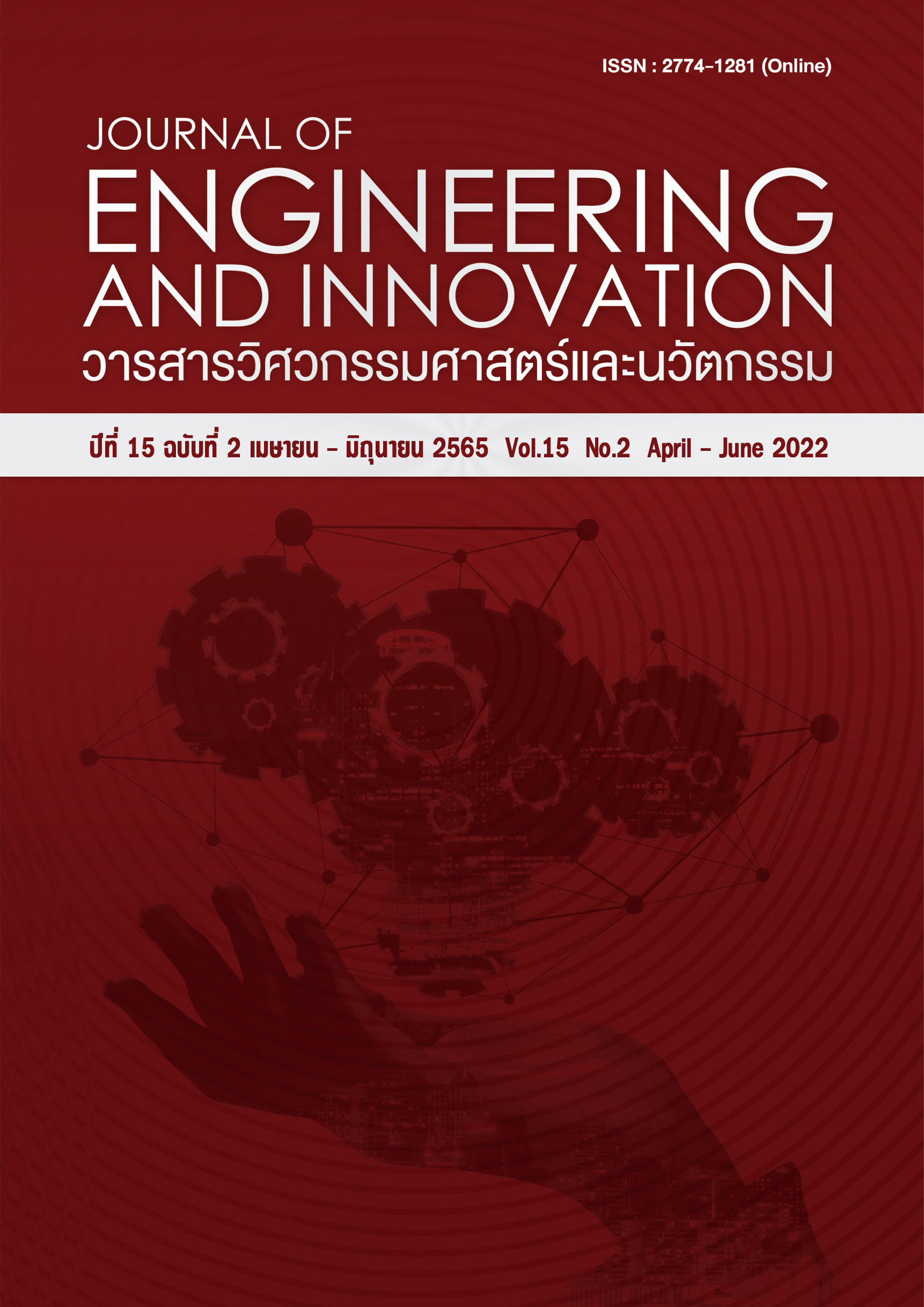Multi-commodity supply chain network design problem considering production cost and inventory holding cost
Main Article Content
Abstract
This study works on an extension of mathematical optimization model by adding more cost components which are production cost at plant and holding cost at supplier and distribution center for the purpose of evaluating the final result and the impact of said costs. To achieve this, one potential existing model of cost minimization is chosen alongside metaheuristics algorithm named Particle Swarm Optimization with multiple social learning terms (GLNPSO) which are then applied to solve the problem. The experiments are conducted based on the data set and test problems from the benchmarks. Then the comparison of optimization models, before and after inclusion of two cost elements, is determined. This comparison stage attempts to illustrate the increasing amount of total cost/solution quality before and after cost inclusion, additionally to observe the coefficient of variation (CV) and average computational time from five replications of each test case problem. Following the benchmarks, the second comparison stage is essentially implemented by re-comparing the two variants of allocation scheme sharing the same proposed Multi-Commodity Supply Chain Network Design (MCSCND) mathematical model. The re-comparison would show whether decision making result remains the same or different from benchmark. Finally, the impact of two cost components is identified and significant to include in mathematical formulation model of location-allocation problem of MCSCND.
Article Details
References
Panfilova E, Dzenzeliuk N, Domnina O, Morgunova N, Zatsarinnaya E. The impact of cost allocation on key decisions of supply chain participants. International Journal of Supply Chain Management. 2020 Feb;9(1):552-8.
Sreyneath C, Lekhavat S. Systematic Literature Review for Location-Allocation Problem under Economic and Environmental Sustainability. Kasem Bundit Engineering Journal. 2019;9(3):253-74.
Shen ZJ. A multi-commodity supply chain design problem. Iie Transactions. 2005 Aug 1;37(8):753-62.
Lekhavat S. Allocation Methods for a Multicommodity Distribution Network Design Problem [Doctoral dissertation]. Asian Institute of Technology; 2013.
Schary PB, Skjøtt-Larsen T. Managing the global supply chain: Handelshøjskolens forlag; 2001.
Kumar S, Chang CW. Reverse auctions: How much total supply chain cost savings are there?—A conceptual overview. Journal of Revenue and Pricing Management. 2007 Aug;6(2):77-85.
Pettersson AI, Segerstedt A. Measuring supply chain cost. International Journal of Production Economics. 2013 Jun 1;143(2):357-63.
Balaman ŞY, Matopoulos A, Wright DG, Scott J. Integrated optimization of sustainable supply chains and transportation networks for multi technology bio-based production: A decision support system based on fuzzy ε-constraint method. Journal of cleaner production. 2018 Jan 20;172:2594-617.
Ruiz-Femenia R, Guillén-Gosálbez G, Jiménez L, Caballero JA. Multi-objective optimization of environmentally conscious chemical supply chains under demand uncertainty. Chemical Engineering Science. 2013 May 24;95:1-1.
Afshari H, Amin-Nayeri M, Jaafari AA. A multi-objective approach for multi-commodity location within distribution network design problem. World Congress on Engineering 2012. July 4-6, 2012. London, UK. 2010 Mar (Vol. 2182, pp. 1526-1530). International Association of Engineers.
Ratnayake MN, Kachitvichyanukul V, Luong HT. A Multi-objective Model for Location-Allocation Problem with Environmental Considerations. Environmental Sustainability in Asian Logistics and Supply Chains 2019 (pp. 205-217). Springer.
Askin RG, Baffo I, Xia M. Multi-commodity warehouse location and distribution planning with inventory consideration. International Journal of Production Research. 2014 Apr 3;52(7):1897-910.
Orozco-Fontalvo M, Cantillo V, Miranda PA. A stochastic, multi-commodity multi-period inventory-location problem: Modeling and solving an industrial application. International Conference on Computational Logistics 2019 Sep 30 (pp. 317-331). Springer.
Farrugia N, Briffa JA, Buttigieg V. Solving the Multi-Commodity Flow Problem using a Multi-Objective Genetic Algorithm. 2019 IEEE Congress on Evolutionary Computation (CEC) 2019 Jun 10 (pp. 2816-2823). IEEE.
Behmardi B, Lee S. Dynamic multi-commodity capacitated facility location problem in supply chain. Iie annual conference. proceedings 2008 (pp. 1914-1919). Institute of Industrial and Systems Engineers (IISE).
Koca E, Yıldırım EA. A hierarchical solution approach for a multicommodity distribution problem under a special cost structure. Computers & operations research. 2012 Nov 1;39(11):2612-24.
Sadjady H, Davoudpour H. Two-echelon, multi-commodity supply chain network design with mode selection, lead-times and inventory costs. Computers & Operations Research. 2012 Jul 1;39(7):1345-54.
Amin SH, Zhang G. A proposed mathematical model for closed-loop network configuration based on product life cycle. The International Journal of Advanced Manufacturing Technology. 2012 Jan 1;58(5-8):791-801.
De Rosa V, Gebhard M, Hartmann E, Wollenweber J. Robust sustainable bi-directional logistics network design under uncertainty. International Journal of Production Economics. 2013 Sep 1;145(1):184-98.
Wu T, Zhang K. A computational study for common network design in multi-commodity supply chains. Computers & operations research. 2014 Apr 1;44:206-13.
Steinke L, Fischer K. Extension of multi-commodity closed-loop supply chain network design by aggregate production planning. Logistics research. 2016 Dec;9(1):1-23.
Ransikarbum K, Mason SJ. Multiple-objective analysis of integrated relief supply and network restoration in humanitarian logistics operations. International Journal of Production Research. 2016 Jan 2;54(1):49-68.
Farias ED, Borenstein D. Modeling the logistics design of a multi-commodity industry. Gestão e produção. São Carlos. Vol. 24, n. 1 (jan./abr. 2017), p. 148-160. 2017.
Gong DC, Chen PS, Lu TY. Multi-objective optimization of green supply chain network designs for transportation mode selection. Scientia Iranica. 2017 Dec 1;24(6):3355-70.
Bortolini M, Galizia FG, Mora C, Botti L, Rosano M. Bi-objective design of fresh food supply chain networks with reusable and disposable packaging containers. Journal of cleaner production. 2018 May 20;184:375-88.
Bevrani B, Burdett RL, Bhaskar A, Yarlagadda PK. A multi commodity flow model incorporating flow reduction functions. Flexible Services and Manufacturing Journal. 2019 Apr 8:1-31.
Ransikarbum K, Pitakaso R, Kim N. A Decision-Support Model for Additive Manufacturing Scheduling Using an Integrative Analytic Hierarchy Process and Multi-Objective Optimization. Applied Sciences. 2020 Jan;10(15):5159.
Suksee S, Sindhuchao S. Selection of locations and incinerators for infectious waste of hospitals in Northeastern Thailand. UBU Engineering Journal. 2021 Mar 12;14(1):48-57.
Kennedy J, Eberhart R. Particle swarm optimization. Proceedings of ICNN'95-international conference on neural networks 1995 Nov 27 (Vol. 4, pp. 1942-1948). IEEE.
Pongchairerks P, Kachitvichyanukul V. Particle swarm optimization algorithm with multiple social learning structures. International Journal of Operational Research. 2009 Jan 1;6(2):176-94.

